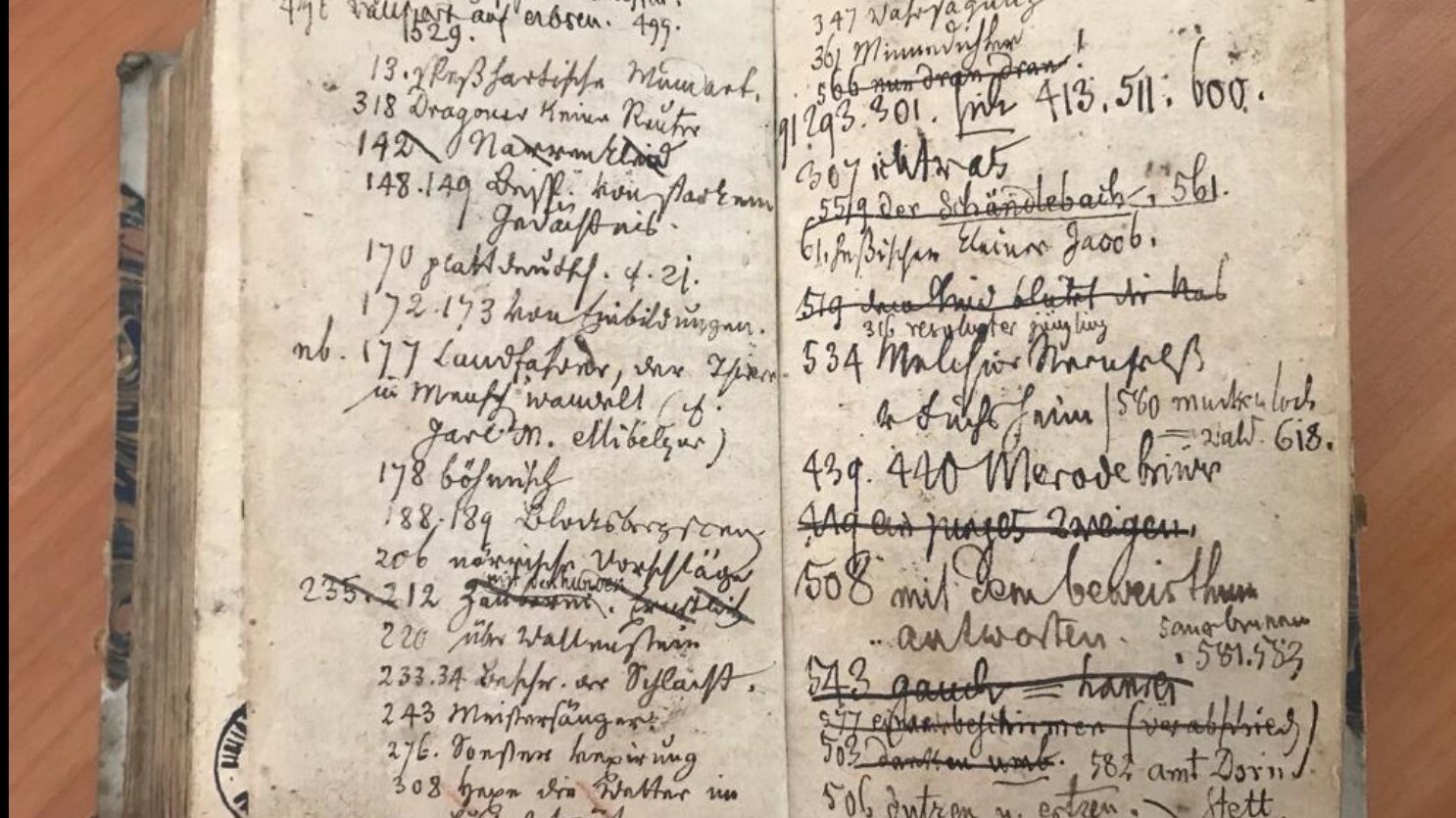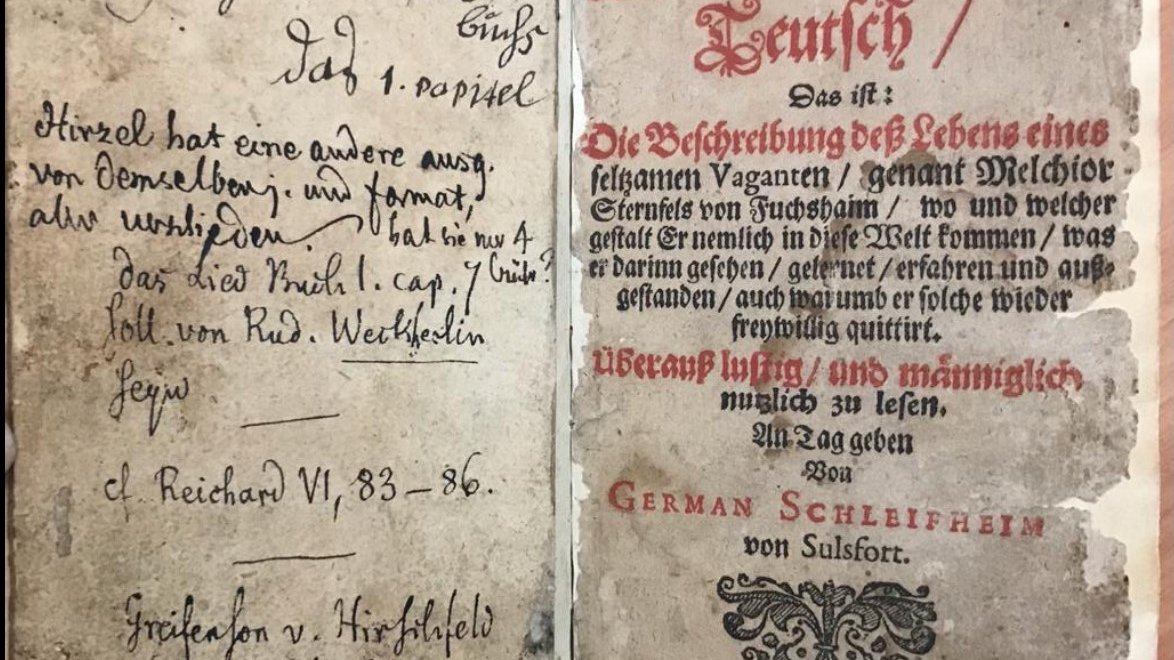A sensational discovery at the University Library in Poznań

Over 60 years of scholarly work, the Grimm brothers have amassed more than 8,000 volumes. After their deaths, most of them ended up in the library of the University of Berlin. They are now a separate special collection at the Humboldt University Library in Berlin. So how did the priceless works from the Wilhelm and Jacob Grimm book collection end up in Poznan?
A long way to Poznan
For many years, the University Library in Poznan has been carrying out provenance research - research that makes it possible to trace works of art back to their origins and find their former owners.
- When transferring titles from the card catalogue to the digital catalogue, we describe the collections in detail and study them, explains Renata Wilgosiewicz-Skutecka from the University Library. - We read the notes of the former owners, examine the stamps found on the works, and describe their bindings. We have known that we have works in the collection previously belonging to the Brothers Grimm since 2002, when we identified the first six volumes. At that time, a catalogue of incunables was created, prepared by prof. WiesławWydra, which contains their description.
Prof. Eliza Pieciul-Karmińska, who has been researching the works of the Brothers Grimm for years, heard about these books from prof. Anna Loba, colleague from the Faculty of Modern Languages at AdamMickiewiczUniversity. Together with curator Renata Wilgosiewicz-Skutecka, they decided to see if there were more works from the famous brothers' library in the Poznan collection.
- The starting point was the catalogue of Ludwig Denecke, who undertook the reconstruction of the private book collection of the Brothers Grimm, says prof. Pieciul-Karmińska. - He spent decades trying to catalogue their books, and also described the works he marked as "lost". So Ms Renata came up with the idea that it would be a good idea to look for books labelled in this way. Fortunately, the Grimms marked their books with signatures, the library in Berlindid likewise, and the Poznan University Library carefully recorded each of these signatures, which made searching easier.
In this way, it became apparent that there are not six, but as many as 33 works previously owned by the Brothers Grimm. It is known that the books once owned by Jacob and Wilhelm Grimm came from Berlin to Poznan as early as 1898-1899, when they were transferred to the Kaiser-Wilhelm-Bibliothek in Poznan, which was being established at the time, as doubles - that is, books that the Berlin library owned in at least two copies. So there was nothing to prevent one of them from being given back to Poznan - to "spread German culture in the East". Other books probably ended up in the University Library in Poznan after the war, when abandoned book collections were secured.
In search of the origins of tales
The works found are valuable for many reasons. Firstly, these are very old prints, of great historical value, and include copies from the late 15th century. Secondly, these books have great sentimental and emotional value as works from the private book collection of the German scholars who collected them over the years.
- An average Polish reader associates the Brothers Grimm mainly with tales; in everyday life we treat them as writers, explains prof. Eliza Pieciul-Karmińska. - Meanwhile, in German culture, these are special figures, eminent scholars, creators of the foundations of German philology. The compilation of tales was only part of their activity; they were also engaged in research into the history of the German language, its grammar. They were also authors of the fundamental Dictionary of the German language. The breadth of their research was truly impressive.
Most important, however, are the brothers' notes, which can be found in the works that have been found. It is an invaluable resource for anyone currently researching their activities. Indeed, Jacob and Wilhelm treated their library primarily as a working tool, so they very often wrote notes directly in the books. William used pencil and James used ink. As they read, they underlined parts of the text and made notes in the margins. They then wrote down their comments on loose sheets of paper and finally transcribed everything neatly on the book's backing board. This allows researchers today to follow the work of the brothers, reconstruct their thinking or possible sources and motifs used in, for example, tales or legends.
- Sometimes one word written in the margins is enough to find out what was important to them - says prof. Pieciul-Karmińska. - First, however, these notes need to be deciphered, which is not always easy. The brothers wrote for themselves, used mental abbreviations, initials. It is also important to see what inspired them to coin a particular word - perhaps they wanted to mark a name of their own in this way, or perhaps they were thinking of a particular tale theme? It is worth remembering that in the early 19th century, when the Grimms began their work of collecting tales, today's Germany was not a unified state, but was broken up into many smaller ones. Therefore, where a particular version of a tale came from, whether it was a reworked French tale or perhaps a Hessian variant, or whether it originated in the Paderborn area, for example, was important information for the Grimms, noted in their handwritten notes and later in footnotes.
The unknown Brothers Grimm
The found works will now be meticulously scanned.
- Incunables found in 2002 are now available digitally, Renata Wilgosiewicz-Skutecka emphasises. - The remaining works are held in the University Library's special collections warehouse. On a day-to-day basis, they are only available to those who deal with the subject scientifically. Once they are digitised, however, everyone will be able to see what is in them.
This is a treat not only for scholars, but also for anyone with an interest in tales - or who wants to learn more about them. And it is definitely worth doing.
- Many of the translations of their tales that we know are often free adaptations,- says prof. Eliza Pieciul-Karmińska. - It is therefore worth reading those translations that do without embellishments and other additions. The authors of the collection of tales saw themselves as collectors of folk tradition and, unlike another famous author of a collection of tales, Hans Christian Andersen, they were not writers. The Grimms have tried quite faithfully to reproduce what they received from their oral informants or what they found in ancient texts. Thus, by reading the tales they have collected, we have access to a much earlier time. I myself recommend reading the earliest versions of their tales, which have not yet been smoothed, censored and adapted to children's readers as part of their editorial work. Many surprising motifs and storylines can be found in them.
The earliest versions of the tales, as translated from the first edition of the original, can be found in the recently published collection "Żylidługoiszczęśliwie, pókinieumarli. Nieznanebaśniebraci Grimm" (Eng. They lived happily ever after, until they died. Unknown tales of the Brothers Grimm) by the publishing house DwieSiostry. This edition contains a selection of fifty tales, including some thirty plots previously unknown in the Polish language.
- These are surprising, fresh and humorous texts - emphasises the scientist, originator and translator of this collection. - They do not yet have the moralising, that "educative spirit" found in later collections. Their characters are not unequivocally good or bad. They are human. As a result, these texts continue to appeal to contemporary readers. Anyway, tales are an extremely important part of culture and Grimm plots are still present in the popular circuit even in the form of pastiche or retelling. Hollywood, Walt Disney Studios, computer games or even Japanese manga are based on them. They are worth reaching for!
AW
See more

Grow in Poznan - an international conference full of inspiration

Networking Workshop at Grow in Poznań - International Conference Supporting Entrepreneurship and...

Grow in Poznan - International Conference Supporting Entrepreneurship and Professional Skills Development


